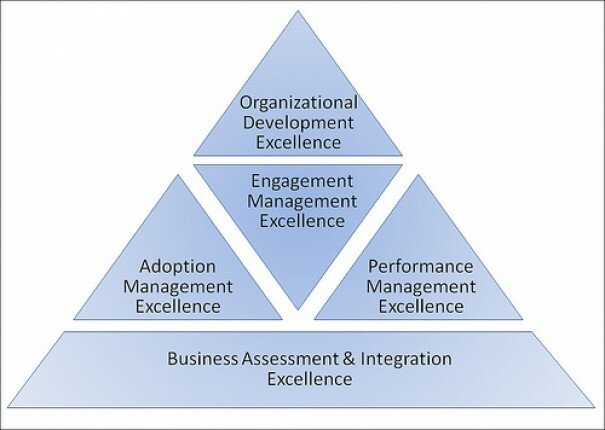Despite of the various on-going projects many companies are still struggling with their Social Business initiatives. Only a few companies have really leveraged a substantial business value from social technology adoption for their organizations. Dion Hinchcliffe, Social Business expert of Dachis Group, even stated in a recent blog post that the alignment and transformation of businesses because of social technology is on a very rocky road and maybe at the “trough of disillusionment”. IDC analyst and blogger Michael Fauscette even asked whether social business is dead.

Source: http://www.zdnet.com/social-medias-rocky-road-in-business-7000010652/
Thinking beyond the adoption of social technology
While social technology is widely spread in today’s corporate world only a few organizations have been taking up the real challenge to the transformative power behind it. The adoption of social technology and the enabled organizational model behind it is about a shift in the way companies work. It’s a shift from the hierarchical information and coordination model to a decentralized and distributed network of power and authority based on knowledge, trust, credibility and a focus on results – as Jon Husband defines it in the notion of the “Wirearchy”.
Within this new cultural approach management thinkers are seeing the real value of “social” – besides the low-hanging fruits of enhancing given processes with better information. It’s about providing the space for creativity, employee engagement and passion. It’s therefore the enablement for innovation and adaptability that is needed in a complex and highly competitive environment. To leverage this shift an evolution of the projects in this field and a revolution in thinking is needed.
Paving the strategic path for the social business success
In comparison to traditioal technology social technology unfolds its additional surplus by its usage which characterizes the paradigm shift behind it. It’s like the organisation of a big party – you can only assure the infrastructure and the guidelines for the festivity but not the value generated by the people coming together. But in order to prevent the effects of the social interactions certain strategic precondition have to be accomplished:
-
Embedding the social initiative into the strategic system of company objectives
The social for the sake of social will not work out. Social as a mean to resolve business problems and to achieve business goals is the right foundation for the project. -
Establishing a social business readiness for change
As mentioned before if the transformative power of social technology is set loose, the organisation as a whole might be questioned and disrupted. This might lead to radical changes in the way the company has done business so far. If the organization – esp. in regards to the top management and its business vision – is not open and therefore ready to this change, the added value of the socially enabled business and process innovation will be diminished and spoiled. -
Guaranteeing the time and freedom to evolve
As the outgrowth of social technology is a reciprocal effect of its application and usage, the initiative needs the time to evolve and the people need the freedom to take part without justifying their participation.
Understanding the new challenges of the E20 project management
Following the above stated strategic approach the tactical project management in regards to the adoption, performance and change management has its own rules. We have to reference again to the example of the party organisation – a good DJ is not forcing people to dance but is providing the good vibes for people to engage in dancing! This is also the key task for the E20 project management.
Therefore the E20 project management is not about forcing people to use and to adapt to the technology but about role modelling, setting guidelines, “gardening” and moderating the context of the social interaction and performance, easeing the use of the technology by helping people to build up social skills, enforcing the adoption by means of virality and gamification and helping people to align and adjust the working routines to new socially enhanced ways of collaborative working.
The E20 project management therefore requires also a change of thinking – that is also the subject-matter of the upcoming E20 SUMMIT in Paris.
Getting beyond the point of failure!
In order to get beyond the point of failure the E20 initiative is facing quite some challenges that only a few organization could yet fully resolve. It is not an easy task and needs quite some effort. At the Enterprise 2.0 SUMMIT in Paris next week we are trying to elaborate the critical factors on how to enable the adoption of social technology and the cultural and organizational transition towards a new model of organization that supports better processes and enables a new kind of business value generation.











 Social Workplace Adoption - The key to success
Social Workplace Adoption - The key to success A competent Adoption Lead is the key to a successful launch
A competent Adoption Lead is the key to a successful launch
 Worlds collide - Constructed reality according to Herbert Mead and Herbert Blumer’s symbolic interactionism
Worlds collide - Constructed reality according to Herbert Mead and Herbert Blumer’s symbolic interactionism Stephan Schillerwein: Intranet-Projekte müssen Antwort auf die Frage „Was ist das Intranet für uns?“ bieten!
Stephan Schillerwein: Intranet-Projekte müssen Antwort auf die Frage „Was ist das Intranet für uns?“ bieten! Oscar Berg: Need for a holistic grip on the digital work environment!
Oscar Berg: Need for a holistic grip on the digital work environment!
Why is this a surprise to anyone?
I got so dismayed hearing Enterprise 2.0 and Social Business hype that I wrote a research-based book about it – Smart Working: Creating the Next Wave, published in January 2013.
Although we are in now in a different world, there is a legacy of learning that remains highly relevant in the experiences of businesses shifting from traditional manufacturing to agile and customer-focused working methods based on quality and lean.
“It’s a shift from the hierarchical information and coordination model to a decentralized and distributed network of power and authority based on knowledge, trust, credibility and a focus on results” – not a million miles off what happened then, I would argue.
We have evidence that many businesses “failed their way to success” and we also have evidence from those who did make the transition. How did they do it it? How did they overcome barriers? I think there is merit in looking backwards to look forwards.
Looking forward to seeing you at the Enterprise 2.0 Summit in Paris on Wednesday.